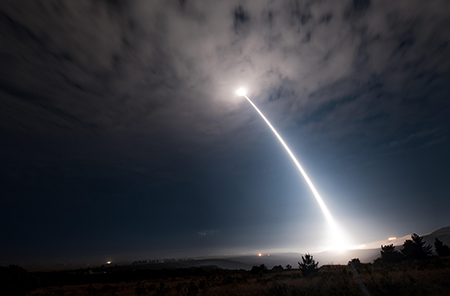Curb the Skyrocketing Cost of U.S. Nuclear Modernization
May 2025
By Daryl G. Kimball
Since Russia and the United States agreed 15 years ago to modest nuclear reductions under the New Strategic Arms Reduction Treaty (New START), they also have embarked on extraordinarily expensive campaigns to replace and modernize every component of their respective nuclear arsenals to maintain force levels and provide the option to build up.

At the same time, their leaders have failed to resolve disputes about existing treaties or launch new negotiations to limit or further cut their deadly arsenals below the New START ceiling of 1,550 deployed nuclear warheads and 700 strategic missiles and bombers each.
In 2018, shortly after he withdrew the United States from the Intermediate-Range Nuclear Forces Treaty, U.S. President Donald Trump foolishly bragged about the nuclear stockpile that “until people come to their senses, we will build it up. It’s a threat to whoever you want, and it includes China, and it includes Russia, and it includes anybody else that wants to play that game.”
China has responded to U.S. nuclear and conventional military plans by pursuing a buildup of its historically “minimal” nuclear force to ensure that it retains an assured “second strike” capability. Russia has continued to develop new types of intermediate range missiles, as well as some new and exotic strategic systems designed to bypass U.S. missile defense capabilities.
Successive presidential administrations and congresses have failed to seriously consider alternatives that would have reduced costs and still maintained a devastating nuclear force.
Now, the cost of the U.S. nuclear modernization program is skyrocketing even further, siphoning resources from other more pressing human needs and national security priorities.
In April, the Congressional Budget Office issued its latest 10-year cost projection of the departments of Defense and Energy plans to operate, sustain, and modernize existing U.S. nuclear forces and purchase new forces: a total of $946 billion in the 2025-2034 period, or about $95 billion per year.
This new estimate is 25 percent, or $190 billion, greater than the last CBO estimate of $756 billion, which covered the 2023-2032 period. Incredibly, the $946 billion estimate does not include all of the likely cost growth of the new Sentinel intercontinental ballistic missile program, which the Pentagon acknowledged in July 2024 would cost 81 percent, or $63 billion, more than the program’s baseline estimate of $78 billion, generated in 2020.
A decade ago, Air Force leaders ignored the results of a 2014 RAND study, commissioned by the service itself, which found that “incremental modernization and sustainment of the current Minuteman III force is a cost-effective alternative that should be considered.” In 2021, the Pentagon decided to ignore a request from 20 Democrats in Congress for an in-depth analysis of whether the existing Minuteman III force, which the Sentinel would replace, could be fielded further into the future.
In the wake of the Sentinel program fiasco, the Pentagon is now looking into extending portions of the Minuteman III force for another decade to 2050 while it restructures the Sentinel program, making the full extent of the cost growth unclear.
What is clear: Building up the U.S. nuclear force beyond New START levels—as Trump threatened in his first term and as some nuclear weapons boosters are advising now—would not only be unnecessary to deter a Russian or Chinese nuclear attack, it would be even more costly. It also would further strain the ability of the U.S. nuclear enterprise to maintain the existing force on schedule and on budget.
Yet, absent a new U.S.-Russia deal to maintain current limits on their strategic nuclear arsenals, a dangerous three-way arms race looms. Perhaps this is why Trump has spoken three times since his January inauguration about the massive costs of nuclear weapons, the catastrophic effects of their use, and his interest in talks with China and Russia to “denuclearize.”
But with New START due to expire in less than a year, there are still no talks underway on whether or how to replace the treaty. Although Russian officials say they are ready to engage, Trump has not outlined a strategy for getting the job done.
U.S.-Russian nuclear arms control negotiations always have been difficult. Achieving a new comprehensive framework could require sustained talks over many months, if not longer.
The smartest approach would be for Russian President Vladimir Putin and Trump to strike a simple, informal deal to maintain the existing caps set by New START as long as the other side also does so. They could agree to resume data exchanges and inspections, or should that not be feasible, monitor compliance through national technical means of intelligence.
Such a deal would reduce tensions, forestall a costly arms race on long-range nuclear missiles that no one can win, and buy time for talks on a broader, more durable, framework deal while also forgoing calls in Congress to throw away billions of dollars more on the already unaffordable and excessive U.S. nuclear arsenal.
